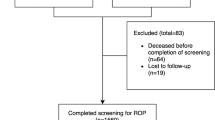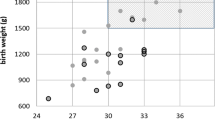Abstract
OBJECTIVE: Retinopathy of prematurity (ROP) is a complication seen in many very low birth weight infants. Severe ROP has been called a “marker” for severe disability. The purpose of this study was to evaluate the occurrence and severity of ROP among infants ≤1250 g birth weight treated in the Special Care Nursery at Women & Infants’ Hospital over a period of 7 years from 1994 to 2000.
STUDY DESIGN: This was a retrospective review of ROP data combined with neonatal follow-up data. Of the 1002 infants born with birth weights <1250 g, ophthalmologic data were available for 739 of 839 survivors. Analysis of variance and χ2 along with logistic regression were used to analyze outcomes.
RESULTS: An increase in the overall occurrence of ROP was identified (40% to 54% linear trend, p=0.007). The occurrence of threshold ROP ranged from 2% to 5% (NS). Infants at greatest risk of ROP were those micropremies with birth weights <750 g (p<0.001).
CONCLUSION: Severe ROP continues to be a significant morbidity among infants <750 g.
This is a preview of subscription content, access via your institution
Access options
Subscribe to this journal
Receive 12 print issues and online access
$259.00 per year
only $21.58 per issue
Buy this article
- Purchase on Springer Link
- Instant access to full article PDF
Prices may be subject to local taxes which are calculated during checkout
Similar content being viewed by others
References
Luginaah IN, Lee KS, Abernathy TJ, Sheehan D, Webster G . Trends and variations in perinatal mortality and low birthweight: the contributions of socioeconomic factors. Can J Public Health 1999;90(6):377–381.
Impact of Multiple Births on Low Birthweight — Massachusetts, 1989–1996. From the Centers for Disease Control and Prevention: Morbidity and Mortality Weekly Report 2 June 1999, Vol. 281(21), 1980–1981.
Hack M, Fanaroff AA . Outcomes of children of extremely low birthweight and gestational age in the 1990's. Semin Neonatol 2000;5(2):89–106.
Lorenz JM . Survival of the extremely premature infant in North America in the 1990s. Clin Perinatol 2000;27(2):255–262.
Hack M, Taylor G, Klein N, Mercuri-Minich N . Functional limitations and special health care needs of 10- to 14-year-old children weighing less than 750 grams at birth. Pediatrics 2000;106(3):554–560.
Msall ME, Tremont MR . Functional outcomes in self-care, mobility, communication, and learning in extremely low-birth weight infants. Clin Perinatol 2000;27(2):381–401.
Msall ME, Phelps DL, DiGaudio KM, et al. Severity of neonatal retinopathy of prematurity is predictive of neurodevelopmental outcome at age 5.5 years. Pediatrics 2000;106(5):998–1005.
Termote J, Schalij-Delfos NE, Brouwers HA, Donders AR, Cats BP . New developments in neonatology: less severe retinopathy of prematurity? J Pediatr Ophthalmol Strabismus 2000;37(3):142–148.
Kennedy J, Todd DA, Watts J, John E . Retinopathy of prematurity in infants less than 29 weeks’ gestation: 3½ years pre- and postsurfactant. J Pediatr Ophthalmol Strabismus 1997;34:289–292.
Bullard SR, Donahue SP, Feman SS, Sinatra RB, Walsh WF . The decreasing incidence and severity of retinopathy of prematurity. J AAPOS 1999;3(1):46–52.
Tin W, Milligan WA, Pennefather P, Hey E . Pulse oximetry, severe retinopathy, and outcomes at one year in babies less than 28 weeks gestation. Arch Dis Child: Fetal Neonatal Ed 2001;84:F106–F110.
Battin M, Ling EWY, Whitfield MF, Mackinnon M, Effer SB . Has the outcome for extremely low gestational age (ELGA) infants improved following recent advances in neonatal intensive care? Am J Perinatol 1998;15(8):469–477.
Bell MJ, Ternberg JL, Feigin RD, et al. Neonatal necrotizing enterocolitis: therapeutic decisions based upon clinical staging. Ann Surg 1978;187:1–7.
Subhani M, Combs A, Weber P, Gerontis C, DeCristofaro JD . Screening guidelines for retinopathy of prematurity: the need for revision in extremely low birth weight infants. Pediatrics 2001;107(4):656–665.
Committee for the Classification of Retinopathy of Prematurity. An international classification of retinopathy of prematurity. Arch Ophthalmol 1984;116:1130–1134.
Gibson DL, Sheps SB, Uh SH, Schechter MT, McCormick AQ . Retinopathy of prematurity-induced blindness: birth weight-specific survival and the new epidemic. Pediatrics 1990;86(3):405–412.
Page JM, Schneeweisss S, Whyte HEA, Harvey P . Ocular sequelae in premature infants. Pediatrics 1993;92;787–790.
Costeloe K, Hennessey E, Gibson AT, Marlow N, Wilkinson AR . The EPICure Study: outcomes to discharge from hospital for infants born at the threshold of viability. Pediatrics 2000;106(4):659–671.
Kinsey VE, Arnold HJ, Kalina R, et al. PaO2 levels and retrolental fibroplasia: a report of the Cooperative Study. Pediatrics 1977;60:665–668.
Flynn JT, Bancalari E, Snyder ES, et al. A cohort study of transcutaneous oxygen tension and the incidence and severity of retinopathy of prematurity. N Engl J Med 1992;326(16):1050–1054.
Penn JS, Henry MM, Wall PT, Tolman BI . The range of PaO2 variation determines the severity of oxygen-induced retinopathy in newborn rats. Investig Ophthalmol Vis Sci 1995;36(10):2063–2070.
Chan-Ling T, Gock B, Stone J . Supplemental oxygen therapy: basis for noninvasive treatment of retinopathy of prematurity. Investig Ophthalmol Vis Sci 1995;36(7):1215–1230.
The STOP-ROP Multicenter Study Group. Supplemental therapeutic oxygen for prethreshold retinopathy of prematurity (STOP-ROP), a randomized, controlled trial I: primary outcomes. Pediatrics 2000;105(2):295–310.
Emond D, Lachance C, Gagnon J, Bard H . Arterial partial pressure of oxygen required to achieve 90% saturation of hemoglobin in very low birth weight newborns. Pediatrics 1993;91(3):602–604.
McIntosh N . Controversy: high or low oxygen saturation for the preterm baby. Arch Dis Child Fetal Neonatal Ed 2001;84:F149–F150.
Saugstad OD . Commentaries: is oxygen more toxic than currently believed? Pediatrics 2001;108(5):1203–1205.
McIntosh N, Marlow N . Controversy: high or low saturation for the preterm baby. Arch Dis Fetal Neonatal Ed 2001;F149–F150.
Chow LC, Wright KW, Sola A . The CSMC Oxygen Administration Study Group.Can changes in clinical practice decrease the incidence of severe retinopathy of prematurity in very low birth weight infants? Pediatrics 2003;111(2):339–345.
Higgins RD, Mendelsohn AL, DeFeo MJ, Uesel R, Hendricks-Munoz KD . Antenatal dexamethasone and decreased severity of retinopathy of prematurity. Arch Ophthalmol 1998;116(5):601–605.
American Academy of Pediatrics. Postnatal corticosteroids to treat or prevent chronic lung disease in the preterm infant; American Academy of Pediatrics policy statement. Pediatrics 2002;109(2):330–338.
Batton DG, Roberts C, Trese M, Maisels MJ . Severe retinopathy of prematurity and steroid exposure. Pediatrics 1992;90(4):534–536.
Sobel DB, Philip AGS . Prolonged dexamethasone therapy reduces the incidence of cryotherapy for retinopathy of prematurity in infants of less than one kilogram birth weight with bronchopulmonary dysplasia. Pediatrics 1992;90(4):529–533.
Wright K, Wright P . Lack of association of glucocorticoid therapy and retinopathy of prematurity. Arch Pediatr Adolesc Med 1994;148:848–852.
Jacobs MAM, Blanco CE . The incidence of retinopathy of prematurity and steroid therapy for broncho-pulmonary dysplasia. J Perinat Med 1998;26:13–16.
Cuculich PS, DeLozier KA, Mellen BG, Shenai JP . Postnatal dexamethasone treatment and retinopathy of prematurity in very-low-birth-weight neonates. Biol Neonate 2001;79(1):9–14.
Hardy P, Varma DR, Chemtob S . Control of cerebral blood and ocular blood flow autoregulation in neonates. Pediatr Clin North Am 1997;44(1):137–151.
Gomella TL, Cunningham MD, Eyal FG, Zenk KE, editors. Neonatology: Management, Procedures, On-Call Problems, Diseases, and Drugs. 4th ed. Stamford, CT: Appleton & Lange; 1999. p. 460–461.
Haroon Parupia MFH, Dhanireddy R . Association of postnatal dexamethasone use and fungal sepsis in the development of severe retinopathy of prematurity and progression to laser therapy in extremely low-birth-weight infants. J Perinatol 2001;21:242–247.
Karlowicz MG, Giannone PJ, Pestian J, Morrow AL, Shults J . Does candidemia predict threshold retinopathy of prematurity in extremely low birth weight (≤1000 g) neonates. Pediatrics 2000;105:1036–1040.
Acknowledgements
We gratefully acknowledge Lory Snady-McCoy, MD of the RI Eye Institute for supporting this research project.
Author information
Authors and Affiliations
Rights and permissions
About this article
Cite this article
O'Connor, M., Vohr, B., Tucker, R. et al. Is Retinopathy of Prematurity Increasing Among Infants Less Than 1250 g Birth Weight?. J Perinatol 23, 673–678 (2003). https://doi.org/10.1038/sj.jp.7211008
Published:
Issue Date:
DOI: https://doi.org/10.1038/sj.jp.7211008



